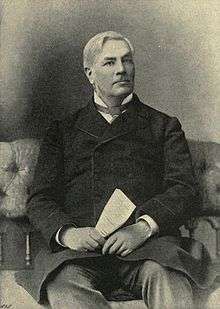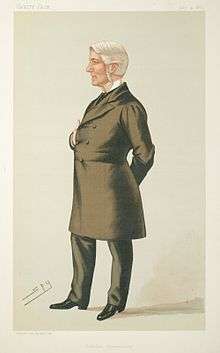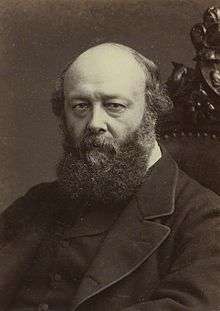Edward Gibson, 1st Baron Ashbourne

Edward Gibson, 1st Baron Ashbourne PC, QC (4 September 1837 – 22 May 1913) was an Irish lawyer and Lord Chancellor of Ireland.
Background and education
Born at 22 Merrion Square, Dublin, Gibson was the son of William Gibson (1808-1872) J.P., of Rockforest, County Tipperary and Merrion Square, Dublin, by his first wife, Louisa, daughter of Joseph Grant, barrister of Dublin.[1] He was the elder brother of John George Gibson, also a distinguished lawyer and judge of the High Court. He was educated at Trinity College, Dublin, graduating BA in 1858, winning the gold medal in History, English Literature and Political Science. He was also an Auditor and a Gold Medallist of the College Historical Society, and became its president in 1883.
Legal and judicial career
Having been called to the Irish bar in 1860, Gibson was made an Irish Queen's Counsel in 1872 and three years later was elected Conservative Member of Parliament for Dublin University after unsuccessfully contesting for Waterford. Enjoying the patronage of Benjamin Disraeli, Sir Stafford Northcote and Lord Randolph Churchill, he was appointed Attorney-General for Ireland in 1877, before being admitted to the Irish Privy Council, and then appointed Lord Chancellor of Ireland in 1885, becoming a British Privy Counsellor that same year.
On his appointment as Lord Chancellor, Gibson was raised to the peerage as Baron Ashbourne, of Ashbourne in the County of Meath in 1885.[2] He was largely single-handedly responsible for the drafting of the Purchase of Land (Ireland) Act 1885 which was commonly known as the Ashbourne Act.[3]

He resigned the Lord Chancellor's office in February 1886 on the return of the Liberals to power, but was reappointed by Lord Salisbury in August of that year. For the next twenty years (with a short interval of three years when Gladstone returned to power in 1892), Lord Ashbourne held office as Lord Chancellor of Ireland, finally retiring at the age of 68. He was highly regarded as a judge even at a time when the Irish Bench boasted such outstanding judges as Gerald FitzGibbon, Hugh Holmes and Christopher Palles.[4] It was in part at least due to his presidency that the Irish Court of Appeal gained a reputation as one of the strongest tribunals ever to sit in Ireland.[5]
In 1900, Winston Churchill's agent Gerald Christie secured Ashbourne's services to take the chair and introduce the journalist /politician's Dublin lecture on his South African Adventures.[6]
Family
Lord Ashbourne married Frances Maria Adelaide Colles (1849–1926), daughter of barrister Henry Jonathan Cope Colles and his wife Elizabeth Mary, daughter of John Mayne of Dublin, in 1868. Lady Ashbourne was a niece of John Dawson Mayne and granddaughter of Abraham Colles. They lived in Fitzwilliam Square and produced four sons, the eldest son and heir being William Gibson, 2nd Baron Ashbourne, and four daughters. One of their daughters, Violet Gibson made an attempt to assassinate Benito Mussolini in 1926. Lord Ashburne died in London in 1913 and was cremated at Golders Green crematorium, his ashes being placed in Mount Jerome Cemetery, Dublin. In Dublin, he was a member of the Kildare Street Club.[7]
References
- ↑ Family of Lord Ashbourne - Visitation of Ireland
- ↑ "New Peers 06 July 1885". Hansard.
- ↑ Dictionary of National Biography, Alvin Jackson
- ↑ Healy, Maurice The Old Munster Circuit Mercier Press Cork p.27
- ↑ Delaney V.T.H. Christopher Palles Alan Figgis and Co. 1960 p.158
- ↑ Churchill; Roy Jenkins
- ↑ Thomas Hay Sweet Escott, Club Makers and Club Members (1913), pp. 329–333
External links
- Hansard 1803–2005: contributions in Parliament by Edward Gibson
| Parliament of the United Kingdom | ||
|---|---|---|
| Preceded by John Thomas Ball and David Robert Plunket |
Member of Parliament for Dublin University 1875–1885 With: David Robert Plunket |
Succeeded by Hugh Holmes and David Robert Plunket |
| Legal offices | ||
| Preceded by George Augustus Chichester May |
Attorney-General for Ireland 1877–1880 |
Succeeded by Hugh Law |
| Political offices | ||
| Preceded by John Naish |
Lord Chancellor of Ireland 1885–1886 |
Succeeded by John Naish |
| Preceded by John Naish |
Lord Chancellor of Ireland 1886–1892 |
Succeeded by Samuel Walker |
| Preceded by Samuel Walker |
Lord Chancellor of Ireland 1895–1905 |
Succeeded by Samuel Walker |
| Peerage of the United Kingdom | ||
| New creation | Baron Ashbourne 1886 – 1913 |
Succeeded by William Gibson |
